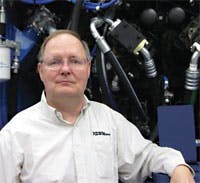editor
[email protected]
Don’t look at me; your guess is as good as mine. But I think we all would agree that fluid power is a mature industry that goes through incremental advancements. Digital microprocessors have made huge contributions to automated control, and new component designs and manufacturing techniques have advanced the physical capabilities of both hydraulic and pneumatic systems.
In my 25+ years with H&P, I have taken part in several articles and presentations about what the future may hold for fluid power. Most predictions have realized only moderate success, the exception being the integration of electronics with fluid power components. However, the evolution of electrohydraulic and electropneumatic technologies has been going on for decades, so it’s not much of a stretch to predict it will continue.
But what predictions were made that have not yet come to pass? One prediction from the 1980s was that valves would become much simpler. Cylinders would be controlled simply by placing a 3-way valve at its rod- and cap-end ports. Electronic sensors and controls would do the rest, and you’d need a solenoid or other device to actuate the valve.
Another prediction was that electro- or magneto-rheological fluids would eliminate moving parts from valves. The viscosity of these fluids increases when they are subjected to a magnetic field or voltage, so — to some extent — you can control fluid flow without any moving parts. Hasn’t happened.
Others projected that the environmental advantages of water hydraulics would make it the system of the future. Despite its many advantages as a hydraulic fluid, water continues to be used primarily in niche applications.
Many outside our industry prophesied that advancements in electromechanical components would capture a huge portion of fluid power applications. That might’ve been true if fluid power had not advanced over the last 30 years. But evolutionary improvements have boosted performance through smart pumps, smart valves, smart actuators, and even hose. Plus, filtration is light years ahead of where it was 30 years ago to make systems run more reliably and longer.
So even if we don’t see the unbelievable progress that has occurred with phones and computers, the steady stream of advancements in the industry promise to keep fluid power a viable means of power transmission well into the future.


